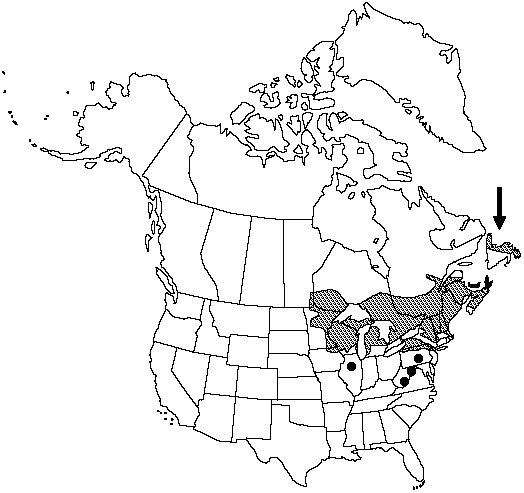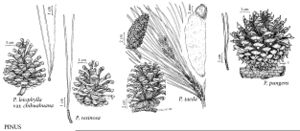Pinus resinosa
Hort. Kew. 3: 367. 1789.
Trees to 37m; trunk to 1.5m diam., straight; crown narrowly rounded. Bark light red-brown, furrowed and cross-checked into irregularly rectangular, scaly plates. Branches spreading-ascending; twigs moderately slender (to 1cm thick), orange- to red-brown, aging darker brown, rough. Buds ovoid-acuminate, red-brown, to ca. 2cm, resinous; scale margins fringed. Leaves 2 per fascicle, straight or slightly twisted, brittle, breaking cleanly when bent, deep yellow-green, all surfaces with narrow stomatal bands, margins serrulate, apex short-conic, acute; sheath 1–2.5cm, base persistent. Pollen cones ellipsoid, ca. 15mm, dark purple. Seed cones maturing and opening in 2 years, spreading, symmetric, ovoid before opening, broadly ovoid to nearly globose when open, 3.5–6cm, light red-brown, nearly sessile; apophyses slightly thickened, slightly raised, transversely low-keeled; umbo central, centrally depressed, unarmed. Seeds ovoid; body 3–5mm, brown; wing to 20mm. 2n =24.
Habitat: Sandy soils, eastern boreal forests
Elevation: 200–800(–1300)m
Distribution

Man., N.B., Nfld., N.S., Ont., P.E.I., Que., Conn., Ill., Maine, Mass., Mich., Minn., N.H., N.J., N.Y., Pa., Vt., W.Va., Wis.
Discussion
Pinus resinosa was once the most important timber pine in the Great Lakes region.
Norway pine (Pinus resinosa) is the state tree of Minnesota.
Selected References
None.
